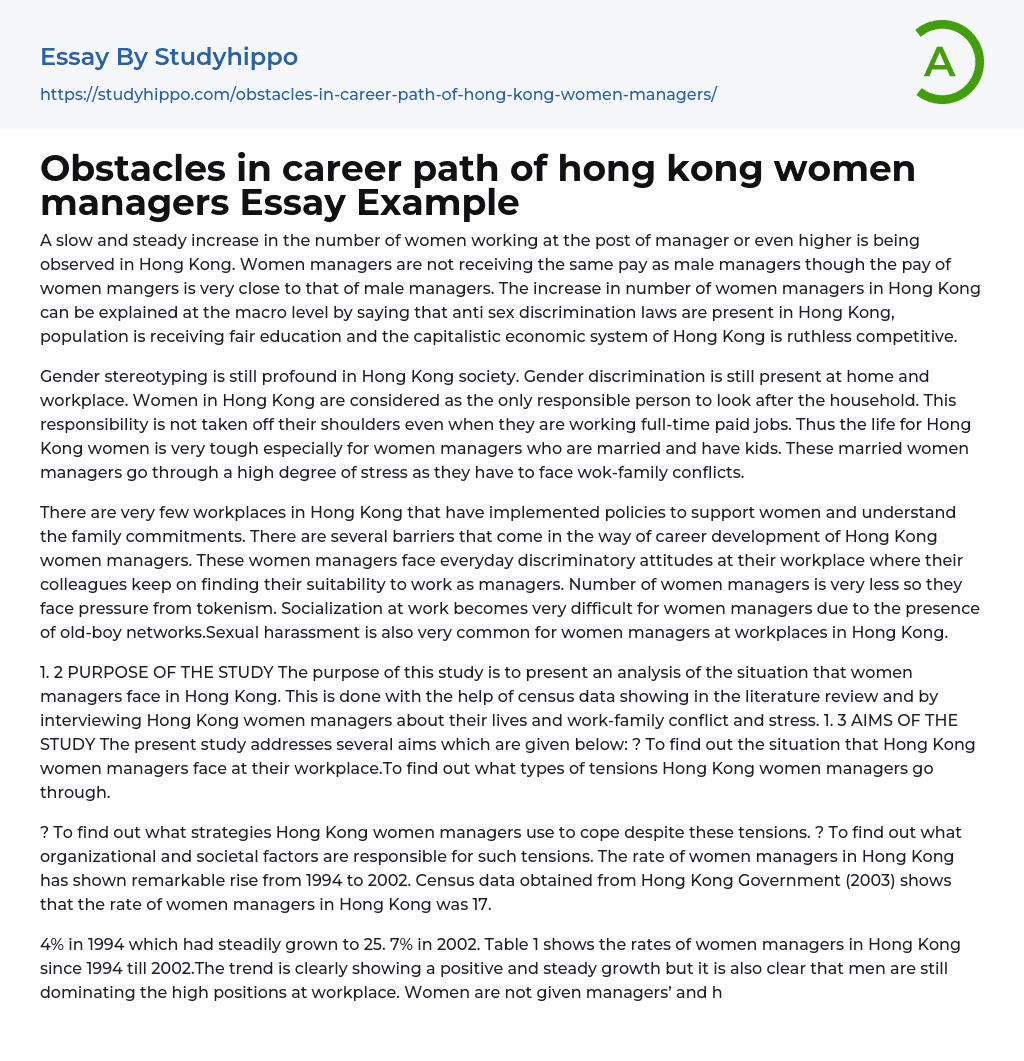

Obstacles in career path of hong kong women managers Essay Example
Although women in Hong Kong have made progress by assuming more managerial and higher-level roles, there is still gender pay inequality even when their salaries are equivalent to those of men. This can be attributed to anti-sex discrimination laws, a fair education system, and a highly competitive capitalist economy that has resulted in an increase in the number of women occupying management positions.
Despite holding full-time jobs, women in Hong Kong face gender stereotyping and discrimination at both home and work. They are frequently expected to take on household tasks, which can create stress for married female managers with children as they struggle to balance work and family responsibilities.
Despite the existence of old-boy networks and discriminatory attitudes towards women managers in Hong Kong, a majority of workplaces do not have policies that support women with their family commitments.
...This results in numerous obstacles for female managers who wish to advance their careers, including tokenism, issues with integrating into workplace culture, and frequent occurrences of sexual harassment.
The purpose of this study is to examine the stress and work-family conflict experienced by female managers in Hong Kong. It will use census data, literature review, and interviews with these women as analytical methods to investigate their workplace situations and identify the different types of pressure they face.
The objective is to investigate the stress management techniques utilized by female managers in Hong Kong and determine the factors that influence it from organizational and societal standpoints. From 1994 to 2002, there was a noticeable surge in the number of women who held managerial positions in Hong Kong. Based on statistics from the Hong Kong Government (2003) census, females accounte
for 17% of all managers in Hong Kong.
Table 1 shows that the proportion of female managers in Hong Kong went up considerably from 4% to 25.7% between the years 1994 and 2002. Though this development is encouraging, men continue to hold most senior positions across all industries, resulting in a disproportionate allocation of managerial and top-level roles for women.
Back in 2001, a discrepancy was noticed within the manufacturing sector regarding the ratio of female workers (38.2%) versus those holding leadership or higher-level positions (19.0%). This suggests that women are not being favored for administrative or managerial roles in this particular industry.
Table 2 shows that the Community, Social and Personal Services (CSPS) sector has a higher proportion of female employees at 63.9%. However, in management and administration roles, women only make up 43.9%, suggesting that CSPS values female managers more than manufacturing does. Although women are well-represented in CSPS, their percentage is still below half.
In Hong Kong, the government made nine years of education mandatory for both boys and girls in 1978, which resulted in women achieving higher education levels, thereby contributing to their professional growth. Mak & Chung (1997) noted that students are legally required to attend school until the age of 15. Additionally, a grant and loan program introduced in 1969 was combined with the compulsory nine years of education.
The grant and loan program aimed to support financially disadvantaged students who could not afford their educational expenses, as well as enforce compulsory education for nine years. This initiative resulted in a significant increase in enrollment numbers across various social backgrounds, including both genders (Mak, 1992). Although government-funded tertiary institutions in Hong Kong saw
more female students than male students (Hong Kong Government, 2003b: 38), some women still faced difficulties finding employment opportunities even after obtaining higher education qualifications. Despite the fact that the labor force participation rate for women rose from 48.9% in 1986 to 52%, it was not universally applicable (Hong Kong Government, 2003b: 38).
According to Hong Kong Government's report in 2003b:52, the female labor force participation rate in Hong Kong was reported as 0% in 1991 but increased to 50.6% by 2002, while the male rate went up from 69.6% to 72.5%. These statistics suggest that education and marriage may have contributed to restricting women's engagement in the workforce.
In 2003, the Hong Kong Government reported that both unmarried men and women had a labor force participation rate of 68%. This trend also applied to those who have never been married. However, once individuals were married, the rate decreased significantly with only 45% of women participating in the labor force compared to 74.8% of men.
- Interview essays
- Job Interview essays
- Career Choice essays
- Career Goals essays
- Portfolio essays
- Community Service essays
- Work-Life Balance essays
- Performance Appraisal essays
- Job essays
- Employee essays
- Skills essays
- Service essays
- Vocation essays
- Internship essays
- Work Experience essays
- Duty essays
- Dream Job essays
- Career Plan essays
- Academia essays
- Higher Education essays
- Language Learning essays
- Studying Business essays
- Education System essays
- Study essays
- First Day of School essays
- Scholarship essays
- Pedagogy essays
- Curriculum essays
- Coursework essays
- Studying Abroad essays
- Philosophy of Education essays
- Purpose of Education essays
- Brainstorming essays
- Educational Goals essays
- Importance Of College Education essays
- Brown V Board of Education essays
- The Importance Of Higher Education essays
- Online Education Vs Traditional Education essays
- Academic And Career Goals essays
- Academic Integrity essays
- Brown Vs Board Of Education essays
- Distance learning essays
- Technology in Education essays
- Vocabulary essays
- Writing Experience essays
- Importance of Education essays
- Early Childhood Education essays
- Academic Degree essays
- Academic Dishonesty essays
- School Uniform essays



